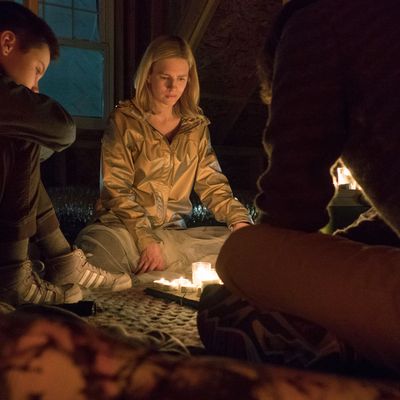
There’s a great moment in The OA when Betty, the middle-aged teacher played by Phyllis Smith, lingers by the table at the cafeteria where four students are sitting. They’re a motley crew: There’s Buck, the trans teenager taking testosterone on the low; French, the all-star scholarship athlete; Steve, the violent bully; and Jesse, the stoner. They’re all talking about Prairie Johnson, and her tale of captivity, mysticism, and near-death experiences. Betty can’t sit with them, but she wants to listen in, so she stands hovering next to them. The school principal watches them from his perch atop the stairwell. “That’s quite an interesting group you’re sitting with,” he tells French, as he leaves for lacrosse practice. “I sort of pride myself on my high-school anthropology, but for the life of me I can’t imagine what the five of you have in common.”
On their own, each of them fits into the world in some coherent way, but together, the five form an odd, nonsensical unit. They literally meet in the fringes of their sleepy neighborhood, gathering at an unfinished house under the cover of night to listen to Prairie Johnson’s (Brit Marling) fantastical tale of her birth, her adoption, and imprisonment by Hap, who experiments on her and her fellow inmates for seven years. It’s an implausible story, but Prairie is a compelling storyteller. Moreover, she exists as living proof of miracles: She was blind, but now she can see. They’re drawn to Prairie for the same reason that she needs them, which is to find a sense of belonging in the world.
Each, in their own way, has experienced the disintegration of the nuclear family, its trauma and abuses. Steve’s parents see him as a menace that needs to be muzzled by way of military boot camp; Buck’s father steadfastly refuses to acknowledge his gender; French becomes the parent of his household in place of a derelict mother; Jesse’s mother committed suicide and his father left; and Betty feels responsible for the death of her twin brother. Prairie, too, sees her adoptive parents as captors — people who misunderstood her and kept her medicated as a child. Their homes were places they needed to escape.
It’s through these relationships that The OA gently, but insistently, weaves a queer narrative. Queer people often demarcate a difference between their “given” and their “chosen” families: that is, the one that you’re often born into versus the one that you make for yourself. The writer and activist Cherríe Moraga describes this process as “making familia from scratch.” Sometimes there’s a violent rupture, or a sense of alienation that forces queer people to seek out and build other worlds. The OA is at its best in the present-day timeline when it allows these relationships to loop together and coalesce: Betty becomes a guardian angel to Steve, rescuing him when his parents abandoned him; Jesse and Steve help her collect her brother’s things; Buck tells French that he’s the kind of guy he wants to become. When Steve asks Prairie, “How did you survive so long down there?” she tells him, “I survived because I wasn’t alone.”
Then, there’s the dancing. How you feel about The OA probably has a lot to do with how you feel about “the Movements,” a series of contemporary dance moves Prairie develops while she’s held captive and experimented on for seven years. Prairie teaches them to the five, telling them that the moves contain a mystical power that can cure illnesses, revive the dead, and open a transdimensional portal. The Movements become a secret language they share together, something that feels akin to drag culture. It is survivalist art. Significantly, four of the characters are teenage boys, who recuperate their sense of self through dance, a feminized art form that often renders male bodies as queer.
Depending on your perspective, the ending was either a moment of beauty, an embrace of the power of art, or completely ridiculous. In the finale, the five face down the shooter with the Movements. The shooter stops in his tracks ostensibly to watch them flutter their arms, grunt, and hiss, which provides an opening for a cafeteria worker to tackle him from behind. Whether by magic or strangeness, they stopped a massacre. TV critics like James Poniewozik, Alan Sepinwall, and Daniel Fienberg all used the words “ludicrous” and “offensive” to describe the show. It’s true: It’s an unbelievable, daring conceit, and demonstrates a radical sincerity in the possibilities of art. The Decider’s Joe Reid points out how audacious it is to use modern dance as a response to terror:
There is something radical, though, about using the human body for beauty as a response to violence or terror. There is something more radical still about using the feminized milieu of modern dance as a battle tactic.
Whether you believe that the Movements actually have mystical powers, or that Prairie was carried along by an invisible current, is sort of beside the point. Many detractors seem to take too much at face value, because they can’t get over the very notion that a response to violence could be contemporary dance moves. Indeed, it requires a leap of faith, a belief that art has a higher purpose and function beyond aesthetics, that it could be used in the face of sheer, unthinkable violence. The Movements allowed Prairie and her fellow prisoners to reclaim their bodies and create a space that their captor could never control. They were a way to resist and forge an identity. The OA is less a story about a myth than it is a story of how myth is made, and our collective, almost primordial need to tell stories that bring us together, bind us, and give us meaning. The OA suggests the sublime exists not in some ethereal realm, but rather in the people around us.

